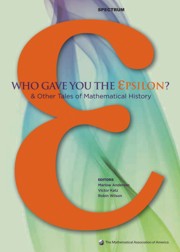Book contents
- Frontmatter
- Introduction
- Contents
- Analysis
- Foreword
- Who Gave You the Epsilon? Cauchy and the Origins of Rigorous Calculus
- Evolution of the Function Concept: A Brief Survey
- S. Kovalevsky: A Mathematical Lesson
- Highlights in the History of Spectral Theory
- Alan Turing and the Central Limit Theorem
- Why did George Green Write his Essay of 1828 on Electricity and Magnetism?
- Connectivity and Smoke-Rings: Green's Second Identity in its First Fifty Years
- The History of Stokes' Theorem
- The Mathematical Collaboration of M. L. Cartwright and J. E. Littlewood
- Dr. David Harold Blackwell, African American Pioneer
- Afterword
- Geometry, Topology and Foundations
- Algebra and Number Theory
- Surveys
- Index
- About the Editors
Connectivity and Smoke-Rings: Green's Second Identity in its First Fifty Years
from Analysis
- Frontmatter
- Introduction
- Contents
- Analysis
- Foreword
- Who Gave You the Epsilon? Cauchy and the Origins of Rigorous Calculus
- Evolution of the Function Concept: A Brief Survey
- S. Kovalevsky: A Mathematical Lesson
- Highlights in the History of Spectral Theory
- Alan Turing and the Central Limit Theorem
- Why did George Green Write his Essay of 1828 on Electricity and Magnetism?
- Connectivity and Smoke-Rings: Green's Second Identity in its First Fifty Years
- The History of Stokes' Theorem
- The Mathematical Collaboration of M. L. Cartwright and J. E. Littlewood
- Dr. David Harold Blackwell, African American Pioneer
- Afterword
- Geometry, Topology and Foundations
- Algebra and Number Theory
- Surveys
- Index
- About the Editors
Summary
Introduction
James Clerk Maxwell, in his review of Thomson and Tait's Treatise on Natural Philosophy, noted an important innovation in the authors' approach to mathematics ([8], Vol. 2, p. 777):
The first thing which we observe in the arrangement of the work is the prominence given to kinematics, … and the large space devoted under this heading to what has been hitherto considered part of pure geometry. The theory of curvature of lines and surfaces, for example, has long been recognized as an important branch of geometry, but in treatises on motion it was regarded as lying as much outside of the subject as the four rules of arithmetic or the binomial theorem.
The guiding idea however…is that geometry itself is part of the science of motion, and that it treats, not of the relations between figures already existing in space, but of the process by which these figures are generated by the motion of a point or a line.
This “guiding idea,”which treats geometric entities as physical objects in some sense, had been influential with mathematicians for many years. Countless mathematical problems have their origin in the investigation of the natural world. However, it also happens that the solutions of some problems may be facilitated by attributing physical properties to the mathematical objects under study. In addition, mathematical constructs usually thought of as “purely geometric” may be created by considering such mathematico-physical entities.
- Type
- Chapter
- Information
- Who Gave You the Epsilon?And Other Tales of Mathematical History, pp. 69 - 77Publisher: Mathematical Association of AmericaPrint publication year: 2009



